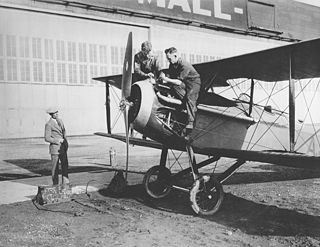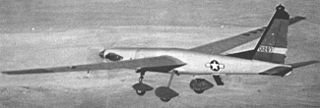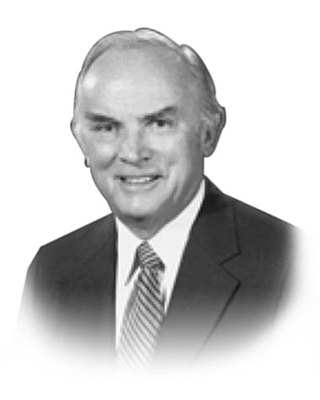
Grand Prairie is a city in the U.S. state of Texas, located in Dallas, Tarrant, and Ellis counties with a small part extending into Johnson county. It is part of the Mid-Cities region in the Dallas–Fort Worth metroplex. It had a population of 175,396 according to the 2010 census, making it the fifteenth most populous city in the state. Remaining the 15th-most populous city in Texas, the 2020 census reported a population of 196,100.
James Joseph "Jimmy" Ling was an American businessman and former head of Ling-Temco-Vought corporation. While at its helm, Ling used LTV funds to purchase a large number of corporations, and was one of the more famous of the 1960s conglomerate managers.

Vought was the name of several related American aerospace firms. These have included, in the past, Lewis and Vought Corporation, Chance Vought, Vought-Sikorsky, LTV Aerospace, Vought Aircraft Companies, and Vought Aircraft Industries.
Ling-Temco-Vought (LTV) was a large American conglomerate which existed from 1961 to 2001. At its peak, it was involved in aerospace, airlines, electronics, steel manufacturing, sporting goods, meat packing, car rentals, and pharmaceuticals, among other businesses.

The Dassault Mirage G, also known as the Mirage IIIG, was a variant of the French Dassault Mirage series of supersonic warplanes, but with a variable-sweep wing. Three prototypes were flown; one single-engined G and two twin-engined G8 examples. Various roles, equipment fits and other variants were proposed, but none entered production.
Altec Lansing, Inc. is an American audio electronics company founded in 1927. Their primary products are loudspeakers and associated audio electronics for professional, home, automotive and multimedia applications.
The Gray Eagle Award is presented to the Naval Aviator on continuous active duty in U.S. Navy or Marine Corps who has held that designation for the longest period of time. A similar trophy, the Gray Owl Award, is also presented to the Naval Flight Officer on continuous active duty in the U.S Navy or Marine Corps who has held that designation for the longest period of time.

The Ling-Temco-Vought (LTV) XC-142 is a tiltwing experimental aircraft designed to investigate the operational suitability of vertical/short takeoff and landing (V/STOL) transports. An XC-142A first flew conventionally on 29 September 1964, and completed its first transitional flight on 11 January 1965 by taking off vertically, changing to forward flight, and finally landing vertically. Its service sponsors pulled out of the program one by one, and it eventually ended due to a lack of interest after demonstrating its capabilities successfully.

The history of Dallas, Texas, United States, from 1946 to 1974 concerns the city during the mid-20th century.
Lear Siegler Incorporated (LSI) is a diverse American corporation established in 1962. Its products range from car seats and brakes to weapons control systems for military fighter planes. The company's more than $2 billion-a-year annual sales comes from three major areas: aerospace-technology, automotive parts, and industrial-commercial. The company, however, is basically anonymous, since its products are either unmarked or bear only the label "LSI". Lear Siegler went private in 1987.

The Grand Prairie Armed Forces Reserve Complex or Grand Prairie AFRC is a former United States Navy Naval Air Station located on Mountain Creek Lake in southwest Dallas. The installation was established as an Army aviation center, and eventually became home to aviation assets from all the military services.

The Temco T-35 Buckaroo was designed in the late 1940s as an extremely low-cost trainer for commercial and military markets. Temco's failure to secure a United States Air Force order for the Buckaroo forced it to turn to non-U.S. governments to keep the production lines going, yet only a few export orders materialized.

John Kenneth Hilliard was an American acoustical and electrical engineer who pioneered a number of important loudspeaker concepts and designs. He helped develop the practical use of recording sound for film and won an Academy Award in 1935. He designed movie theater sound systems, and he worked on radar as well as submarine detection equipment during World War II. Hilliard collaborated with James B. "Jim" Lansing in creating the long-lived Altec Voice of the Theatre speaker system. Hilliard researched high-intensity acoustics, vibration, miniaturization and long-line communications for NASA and the Air Force. Near the end of his career, he standardized noise-control criteria for home construction in California, a pattern since applied to new homes throughout the U.S.

The Ling-Temco-Vought XQM-93 was a remotely piloted aircraft developed in the United States in the late 1960s and early 1970s for use as a communications relay in the Vietnam War. A prototype flew in 1970, but the program was abandoned without producing a service-ready aircraft.

William Paul Thayer was an American test pilot, flying ace, aviation executive, and United States Deputy Secretary of Defense during the Reagan Administration.

The Intercontinental Manufacturing Company (IMCO) was formed in the Dallas, Texas area in 1948 by Harold J. Silver and Robert F. Yonash, initially to fulfill an order from Argentina for tractors. IMCO soon changed focus to defense subcontracting, where it remains today.

Robert F. Yonash was an American engineer in the early days of the aircraft industry. He was a member of the start-up management team for the Texas Engineering & Manufacturing Company (TEMCO), which eventually became the "T" in the conglomerate Ling-Temco-Vought (LTV). He was the co-founder, with Harold Silver, of the Intercontinental Manufacturing Company (IMCO), which is currently owned by General Dynamics.

Charles Edward Acker is an American businessman who was CEO of Braniff Airways, Air Florida, and Pan American World Airways. He is a principal at Intrepid Equity Group.
David Harold "Dry Hole" Byrd was a noted Texan producer of petroleum, and a co-founder of the Civil Air Patrol. Byrd's cousin, polar explorer Richard E. Byrd, named Antarctica's Harold Byrd Mountains for him.














